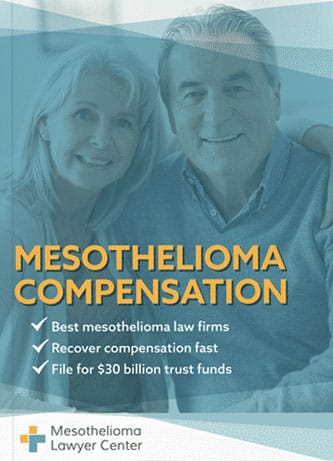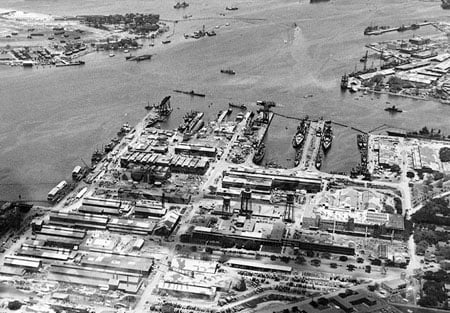Pearl Harbor played an infamous role in history, with the attack that led to the U.S. entering World War II. Pearl Harbor Naval Shipyard’s use of asbestos is less well-known, but still caused harm. Workers and Navy veterans exposed to asbestos in Pearl Harbor later faced the risk of serious illnesses like mesothelioma.
If you or a loved one suffer from mesothelioma, asbestos-related lung cancer, or asbestosis, you may qualify for substantial compensation. Currently, there is over $30 billion in asbestos trust funds, awaiting those who’ve been diagnosed with an asbestos illness. Le invitamos a completar nuestro formulario hoy para obtener una cotización gratuita. Paquete de compensación financiera, lleno de información sobre abogados con experiencia en mesotelioma en su área, cómo recibir el pago en 90 días, cómo presentar un reclamo ante un fondo fiduciario de asbesto y mucho más.


Paquete de compensación financiera GRATUITO
- Información sobre despachos de abogados que recuperarán su INDEMNIZACIÓN MÁS ALTA
- Aprenda cómo cobrar en 90 días
- Solicite su parte de $30 mil millones en fondos fiduciarios

Did Pearl Harbor Naval Shipyard Use Asbestos?
Pearl Harbor Naval Shipyard used asbestos in many ways and for many years. Peak asbestos use in all shipyards occurred between the 1930s and 1970s.
While Pearl Harbor and other shipyards no longer use asbestos today, the harm was done. Former workers and Navy veterans risked harmful exposure. Many were later diagnosed with mesotelioma, asbestosis, cáncer de pulmón, and other illnesses.
Pearl Harbor Naval Shipyard History
Pearl Harbor Naval Shipyard was founded in 1899, shortly after the annexation of Hawaii. It was initially created as a way to allow room for more vessels.
Over the years, over 80 acres were added, and the Navy spent time upgrading the shipyard. Upgrades included machine shops, housing, a smith and foundry, and much more.
Throughout the early and mid-1900s, Pearl Harbor Naval Shipyard continued to expand and develop further, including widening the channels for the area to accept much larger vessels.
During World War I, Pearl Harbor played a significant role in helping defend the West Coast of the nation. It was known as the “Gibraltar of the Pacific.”
Once the Great Depression hit the U.S., production and expansion slowed considerably at the shipyard for many years, lasting until World War II.
In 1941, Pearl Harbor was attacked and bombed by Japan. It became one of the most well-known and one of the most tragic events in U.S. history.
The surprise attack spurred the launch of World War II, and once again, the shipyard began expanding and developing to help accommodate the war. Along with massive expansion came the use of asbestos and asbestos-containing products.
Pearl Harbor Naval Shipyard Today
Pearl Harbor today is the Pearl Harbor Naval Shipyard and Intermediate Maintenance Facility located a few miles from the Honolulu International Airport. It sits on over several hundred acres on the island of Oahu.
Pearl Harbor serves as one of the largest repair and maintenance facilities for the U.S. Navy. It employs about 6,000 people who service destroyers, aircraft carriers, submarines, and more.
How Was Asbestos Used at Pearl Harbor Naval Shipyard?
Pearl Harbor Naval Shipyard relied on asbestos in the past. Peak asbestos use by most shipyards in the U.S. lasted from the 1930s through the 1970s.
As a ship repair facility, Pearl Harbor Naval Shipyard used many of the same asbestos-containing materials (ACMs) that were once used at civilian shipbuilding facilities.
The U.S. Navy has stated that more than 250 different types of asbestos-containing products were used at shipyards. Some of the many components that went into ships at Pearl Harbor and contained asbestos include:
- Aislamiento
- Pipes
- Cemento
- Adhesivos
- Calderas
- Juntas
- válvulas
Who Was Affected by Asbestos at Pearl Harbor?
The National Institutes of Health (NIH) reports that people who worked at the Pearl Harbor Naval Shipyard were found to have a heightened risk of cáncer de pulmón.
There is also a heightened increase in developing mesothelioma compared to shipyard workers in other parts of the U.S.
Anyone who worked at or served at Pearl Harbor during the peak years of asbestos use could have been exposed. They were put at risk of later illnesses, like mesothelioma and lung cancer.
Some workers had greater risks than others. They handled asbestos materials directly or worked very closely with them:
- trabajadores de aislamiento
- Instaladores de tuberías
- trabajadores de calderas
- Steamfitters
- Soldadores
- electricistas
- Repair workers
Both civilian workers and U.S. Navy service members risked asbestos exposure at Pearl Harbor. A benefits claim filed with the U.S. Department of Veterans Affairs highlights this.
The veteran who made the claim worked as a civilian at Pearl Harbor before enlisting in the military. He was exposed to asbestos in the shipyard for four years. He later developed asbestosis and lung cancer.
Pearl Harbor Naval Complex Superfund Site
The U.S. Environmental Protection Agency (EPA) designated Pearl Harbor a Superfund site in need of cleanup and remediation. The Complex includes 12,600 acres encompassing both water and land.
Among the many contaminants in the Pearl Harbor Naval Complex is asbestos. The EPA, the U.S. Navy, and the state of Hawaii are all involved in cleanup efforts. Cleanup and testing are ongoing.
Compensation and Benefits for Asbestos Exposure at Pearl Harbor
Both civilians and veterans have a right to seek compensation for asbestos illnesses as a result of exposure at Pearl Harbor.
Veterans cannot sue the military or government. Both civilians and veterans can sue the asbestos companies that supplied shipyards. These lawsuits often lead to settlements for the victims.
Another source of compensation is an asbestos trust fund. These are funds set up by asbestos companies that went bankrupt and can no longer be sued.
Veterans can file for Beneficios del VA. These include monthly disability compensation, medical care, and benefits for dependents.
If you have mesothelioma and worked or served at Pearl Harbor when asbestos was used, contact a mesothelioma lawyer. They can help you take legal action, claim with a trust fund, or get the veterans benefits you are owed.
Additional Information and Helpful Resources for Asbestos Victims
If you’ve been injured by mesothelioma, asbestos-related lung cancer, or asbestosis, keep in mind that there is a good chance that you’ll qualify for considerable compensation. Remember to fill out our form to get your free Financial Compensation Packet, with information on asbestos and mesothelioma lawyers. If you have questions or need additional assistance, contact us at 800-793-4540.

Pablo Danziger
Revisor y editorPaul Danziger creció en Houston, Texas, y se licenció en Derecho en la Facultad de Derecho de la Universidad Northwestern en Chicago. Durante más de 25 años, se ha dedicado a representar a víctimas de mesotelioma y a otras personas afectadas por la exposición al asbesto. Paul y su bufete han representado a miles de personas diagnosticadas con mesotelioma, asbestosis y cáncer de pulmón, obteniendo indemnizaciones significativas para los clientes lesionados. Cada cliente es fundamental para Paul y atenderá todas las llamadas de quienes deseen hablar con él. Paul y su bufete se encargan de casos de mesotelioma en todo Estados Unidos.
Conéctese con el abogado especializado en mesotelioma Paul Danziger
Referencias
- Naval Sea Systems Command. (n.d.). Pearl Harbor Naval Shipyard & IMF.
Recuperado de: http://www.navsea.navy.mil/shipyards/pearl/default.aspx - Kolonel, L.N., Yoshizawa, C.N., Hirohata, T., and Myers, B.C. (1985, August). Cancer Occurrence in Shipyard Workers Exposed to Asbestos in Hawaii. Cancer Res. 45(8), 3924-8.
Recuperado de: http://www.ncbi.nlm.nih.gov/pubmed/4016758 - U.S. Environmental Protection Agency. (n.d.). Superfund Site: Pearl Harbor Naval Complex Pearl Harbor, HI.
Recuperado de: https://cumulis.epa.gov/supercpad/cursites/csitinfo.cfm?id=0904481 - U.S Department of Veterans Affairs. (2010, July 19). Citation Nr: 1025397.
Recuperado de: https://www.va.gov/vetapp10/files3/1025397.txt - Photo Source: U.S. National Archives. Public Domain
